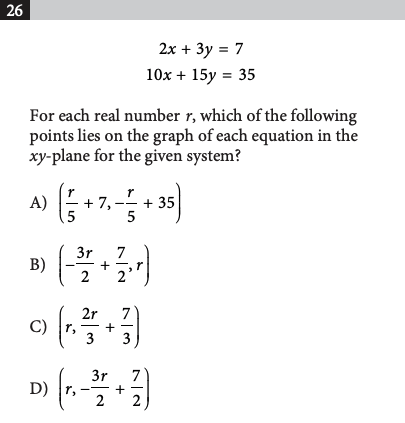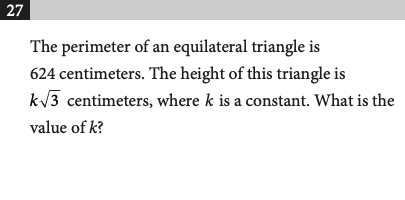Digital SAT Math
Table of contents
SAT Math Structure
The SAT math exam consists of 2 modules, each with 22 questions. That means your SAT math exam contains a total of 44 questions, 70 minutes of effective time to solve them, and a score range between 200 and 800 points.
The first module is “common” to all candidates. If you are observant, you will have noticed that “common” is in quotes. The reason is that College Board generates multiple math module 1s to avoid the temptation to look at your friend’s exam. However, despite the fact that your module 1 is different from others, the College Board guarantees an identical level of difficulty for all candidates.
Once you have completed module 1, you will move on to math module 2. In this transition, depending on your previous module result, you will access the upper or lower math module 2. The superior or inferior nomenclature refers to the difficulty of the questions. That is, if you did well in module 1, module 2 will be more difficult than if you made several errors in module 1. Like module 1, your module 2 will not be the same as your friend’s. Check out this link to our article on SAT scores so you can better understand how it works.
Contact Us And Find Out Why We've Been Achieving The Best Results Since 2010
If you have unresolved questions, contact us and we will explain how we can help you achieve your goals.
Types of SAT Math Questions
In the math exam, you will only find 2 types of questions:
- Multiple choice questions: the majority of the exam will be this type of question. You will be given a statement and four options, of which only one option will be correct. Remember that, despite being test-type questions, errors do not penalize by subtracting points. Check out this example published on the College Board:

- Questions with student-generated answers: some of the questions you will find on the day of the exam will be of the type statement and a blank space where you must enter the answer. Here is an example published on the College Board website:

Tested Concepts
If you are not familiar with how mathematics is taught in the North American educational system, it is very likely that you will struggle with this type of exam at first. To give you a better understanding of the concepts tested on the SAT math exam, we have prepared a classification with the areas that you will be evaluated on:
- Arithmetic: a discipline of calculus that deals with operations involving whole or rational numbers. Here you will face problems involving calculations of ratios, proportions, percentages, and more.
- Algebra: a discipline of pure mathematics that deals with the rules of operations and the solution of equations. On the exam, you will be asked questions related to the calculation of exponents, radicals, equations, systems of equations, functions, complex numbers, and more.
- Geometry: a part of mathematics that studies the properties of lines, planes, angles, shapes, and the relationships between them. Here you will be asked questions about polygons, 3D figures, parallel and perpendicular lines, trigonometry, and more.
- Statistics: the science that studies data in an aggregated form to obtain explanatory conclusions about the sample. The questions you will find will be about probability and statistical indicators such as mean, median, mode, and more.
In the case of the SAT, unlike other exams such as the ACT, it requires that you have deep knowledge of mathematics, especially if you aspire to get a high score on this exam.
Digital SAT Math Changes
The Digital SAT has introduced significant changes. Regarding the math section, we will analyze what these changes are and what implications they have:
- There is no longer a section without a calculator: in the paper-based test, the math exam was divided into two parts: one with a calculator and one without a calculator. Currently, you can use a calculator for the entire exam. It seems that College Board aligns with the thinking that mental calculations will tend to be separate from the necessary skills of a person.
- Resolution times: In the paper-based test, the times were 75 and 87 seconds per question for No-Calculator and Calculator, respectively. Currently, the resolution time per question has increased to 95.5 seconds per each question.
It is important to also analyze what remains the same in the math exam:
- Evaluated concepts: the fact that the section without a calculator has disappeared could lead one to think that the concepts tested in the exam have been altered. Well, after thorough analysis, we can affirm that there has been no change in this regard. The concepts and their weights remain the same as they were in the paper-based test.
- Formulas sheet: Just like the paper-based test, you will be provided with a sheet with some formulas for solving the exercises. The formulas provided are quite basic and you must know more formulas than the ones provided to you. For this reason, we have created our EPIC Must Know Formulas for Digital SAT success. Click here to access it!=)
- Level of difficulty: although it is too early to draw conclusions (when this article is written, only one Digital SAT has taken place), it does not seem that College Board will lower its level. Remember that they are the global standard used by the most prestigious universities in the world. That is not going to change (at least in the short term), so they will continue to maintain their high level of demand. In fact, the average score in 2022 was the lowest in the last 5 years.
In the case of the SAT math exam, it seems that the famous phrase “change everything so that nothing changes” applies.
How to Solve the SAT Math Exam
The SAT is an exam where it’s not enough to just participate. The competition is not against oneself but against the millions of exam takers annually. Remember that the ultimate goal of a standardized exam is to rank all the candidates so that institutions have a benchmark to compare them. Have this mindset when facing the preparation for the SAT math exam.
Regarding what to do for the resolution, you must separate it into:
- Preparation process prior to the exam:
- Structure your preparation logically: the SAT is not a driver’s license. It’s not enough to take tests if you don’t have a solid understanding of the mathematical concepts on which you will be evaluated. Remember that the number of questions is infinite and even more so in an era like the one we are heading into, where machines can generate infinite combinations.
- Practice non-stop: although it may seem contradictory to the previous point, it is not at all. To have a solid foundation, you need to know the concepts in depth and practice them extensively. Remember that every second you gain on the clock can count in your final performance.
- Memorize the most common formulas: at EPIC PREP, we don’t believe in memorization but in understanding. However, knowing the most common formulas by heart will allow you to solve exercises more quickly. It’s not enough to be effective; you must be efficient.
- Considerations for exam day:
- Bring your own calculator: even though the Bluebook has an integrated calculator, we recommend that you bring your own calculator for exam day. You will always be faster with an external calculator than with the application’s calculator. Here’s the link for you to check if your calculator is allowed.
- Don’t stop if you don’t know an answer: remember that each math exam module has 22 questions. No one obligates you to answer in the order they appear. If you read a question and in the first 5 seconds you are sure you don’t know the answer, flag it for later. The Bluebook allows you to put a signal so that you can go back to it before finishing the module.
- Familiarize yourself with the Bluebook: solve a complete math exam in the Bluebook to avoid usability surprises on exam day.
- Decide how to manage the clock: remember that a clock appears on the screen. You can hide it or keep it. Be clear before entering the exam whether having it will help or hinder you due to your personality. If it doesn’t cause you anxiety, it’s a very useful tool. On the other hand, if it could negatively affect your performance, hide it and enable it from time to time.
- Preparation process prior to the exam:






